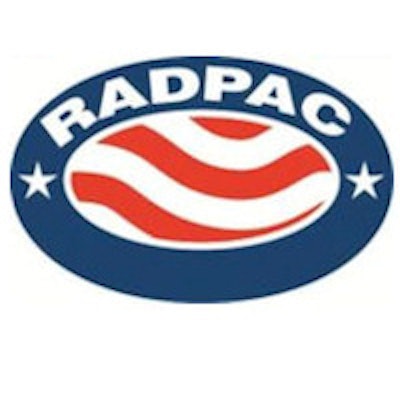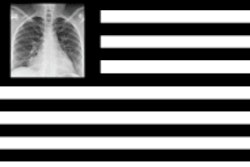
Radiology residents don't mind contributing to U.S. radiology's RADPAC political action committee -- that is, unless they're young, in debt, or have kids, according to a survey published in the Journal of the American College of Radiology.
"The ones who typically don't contribute are the ones who don't know what RADPAC does," author Dr. Tirath Patel, a third-year radiology resident at the University of Toledo, told AuntMinnie.com. In terms of demographics, "noncontributors are typically the ones with higher educational debt. These are the two big things -- and educational debt and the cost of raising children aren't things that can be fixed overnight, obviously."
 Dr. Tirath Patel from the University of Toledo.
Dr. Tirath Patel from the University of Toledo.
RADPAC is a federal-level political action committee associated with the American College of Radiology (ACR) Association that advocates in Congress for diagnostic radiology, interventional radiology, and radiation oncology professionals. The organization took in a little more than $1.3 million from 3,049 contributors in 2013, according to its website.
Radiology residents were more willing to consider regular political contributions if their student debt levels were manageable, they were older than 30 years, and they had no children, the survey found (JACR, March 2014, Vol. 11:3, pp. 332-334).
Residents in general and radiology residents in particular have traditionally not been involved in political advocacy, citing time constraints and the belief that legislation has little direct effect on their lives, Patel said.
But as a RADPAC contributor himself, Patel is a firm believer in the old political adage, "If you're not at the table, you're on the menu."
Surveying residents
For the project, Patel sent 65 email requests to radiology residents in Ohio, sweetening the pot with a gift-card raffle. The survey asked residents about their training level, age, marital status, homeownership, and student debt burden, before asking what contribution level seemed reasonable. Statistical significance was determined by means of two-tailed z-tests at the 95% confidence interval.
In all, 53 (82%) of the residents completed the survey, and slightly less than half (n = 25, 47%) said they would be willing to contribute to RADPAC on a recurrent basis. Demographics of the respondents in general and those who said they would contribute to RADPAC either once per month or biweekly are shown in the table below.
| Demographics of respondents, potential contributors | ||
| Respondents | Those willing to contribute on recurrent basis | |
| Gender | ||
| Male | 43 (81%) | 21 (49%) |
| Female | 10 (19%) | 4 (40%) |
| Age (years) | ||
| 26-27 | 3 (6%) | 1 (33%) |
| 28-29 | 16 (30%) | 6 (38%) |
| 30-31 | 20 (38%) | 10 (50%) |
| 32 or older | 14 (26%) | 8 (57%) |
| Children | ||
| Yes | 12 (23%) | 2 (17%) |
| No | 39 (74%) | 23 (59%) |
| Educational debt | ||
| Less than $20,000 | 6 (11%) | 5 (83%) |
| $20,001-$50,000 | 6 (11%) | 4 (67%) |
| $50,001-$150,000 | 17 (32%) | 8 (47%) |
| $150,001 or more | 22 (42%) | 10 (45%) |
In addition, 52% of the unmarried respondents indicated they would contribute, compared with 42% of the married respondents. In terms of homeownership, the respondents who indicated they would contribute were roughly split (48% owned, 46% did not).
As for political awareness, respondents who agreed -- either strongly or somewhat -- with the statement "I have no idea what RADPAC does for me" were less likely to contribute than those who somewhat or strongly disagreed with the statement (p = 0.01). Also, those who contributed to RADPAC in the past were more likely to support recurrent contributions that those who had not made prior contributions (p = 0.01).
Residents were most amenable to monthly contributions of $5, with 45% agreeing to that level. About 38% were willing to donate $10 per month, but a surprising 55% said they were willing to contribute $10 or more per month.
Awareness grows among higher-level trainees
Younger trainees and those early in training were generally less willing to contribute than their older counterparts, though the under-30s are a small group because most residents don't begin until at least age 27, Patel said. Those unwilling to contribute were both younger and less educated about the active role of the federal government in radiology.
"I think this has to do with the fact that as trainees progress, they are more worried about their job prospects and income, and they're more knowledgeable about what the federal government is doing as far as their income is concerned," he said. "There's more knowledge of why they should be politically active and advocate for their profession."
The weak job market, reimbursement cuts, the potentially troubling effects of the Affordable Care Act on income, and other factors all appear to contribute to residents' increasing willingness to become more politically active, Patel said.
"There are enough things coming down the pipeline ... that people are willing to become politically active because they see it as a way to keep their future incomes," he said.
"I think if you can educate more trainees about what RADPAC is and what it does, they may be more willing to contribute," Patel added.
Does it do any good?
Patel said he's gotten an earful from residents and attending physicians who say RADPAC, for all its money and power, was useless in preventing last year's $800 million in imaging reimbursement cuts from the federal government. But that's the wrong way to look at things, he believes.
"I think a lot of people don't realize that the cuts would be a lot deeper if there weren't political contributions from radiologists," he said.
Take the recent multiple procedure payment reduction (MPPR) of 25% of the professional fee component that applies to a second procedure performed shortly after the first.
"The original language of that bill wasn't 25%, it was 50%," Patel said. "The cuts would have been more if radiologists weren't involved in lobbying through RADPAC. And I don't think a lot of radiologists -- and trainees, specifically -- fully understand that."
Trolling for dollars
ACR has recently undertaken some initiatives to increase resident involvement in political advocacy, Patel wrote. For example, residents and fellows can now apply for a one-year J.T. Rutherford Fellowship in government relations, working with the ACR's Government Relations Division.
In addition, a YouTube video shown to residents at the 2013 Annual Meeting and Chapter Leadership Conference (AMCLC) in Washington, DC, relayed the importance of RADPAC contributions, and many residents visited lawmakers on Capitol Hill Day.
The ACR Resident and Fellow Section (RFS) has also created a residency advocacy committee with the aim of boosting political advocacy.
"The current advocacy efforts are commendable, but additional work must be done to increase trainees' contributions to radiology political advocacy efforts," Patel wrote in the JACR article. "Perhaps we can glean some ideas from the worlds of advertising and behavioral economics. Many times when watching infomercials, one hears the phrase '3 easy payments of $39.99!' "
Similarly, trainees seem more willing to contribute small amounts on a regular basis; as mentioned, many would be willing to contribute $5 or $10 monthly, based on the survey's results.
For his part, Patel said he plans to continue his advocacy efforts, and he might broaden his survey to include a national sample of radiologists and fellows.
"Residents and fellows are an important part of the population as far as radiology is concerned, and getting involved in legislation and lobbying, I think, is critical for the profession," he said. "So having information about them and their sense of contribution is kind of an important thing."



















